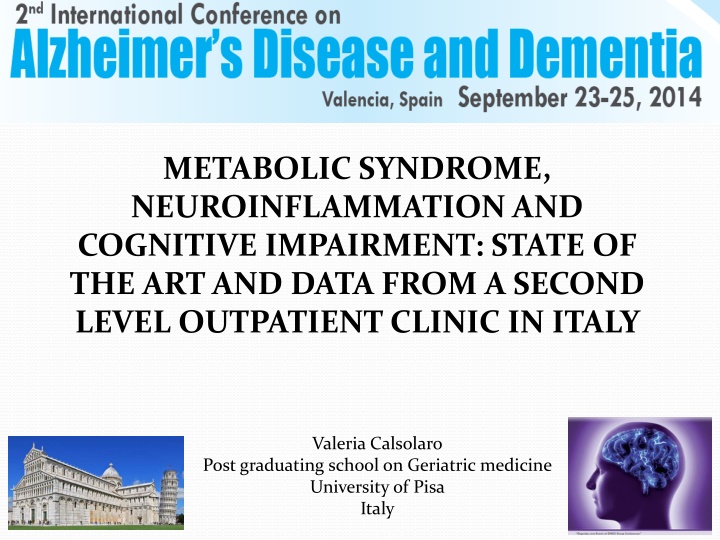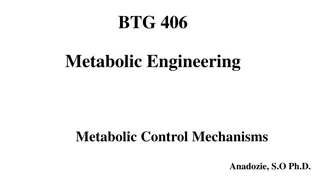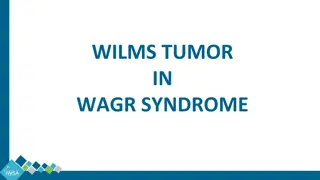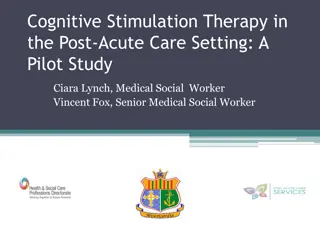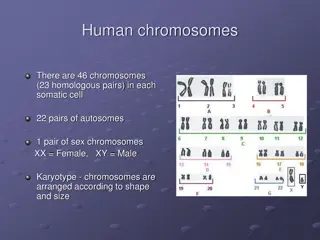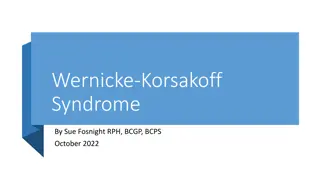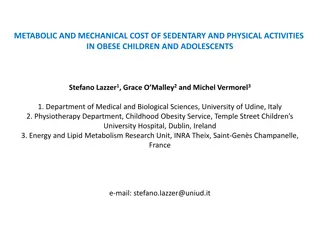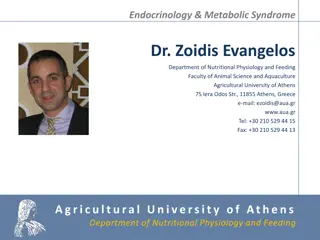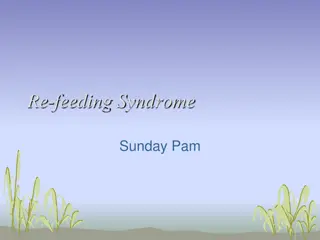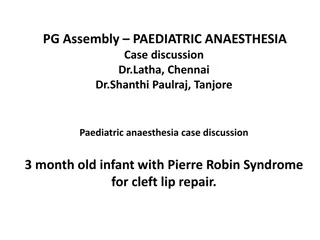Metabolic Syndrome, Neuroinflammation, and Cognitive Impairment: Data and Insights
Metabolic syndrome, neuroinflammation, and Alzheimer's disease are complex conditions impacting cognitive function. Research indicates a link between amyloid deposition, neuroinflammation, and neurodegeneration in Alzheimer's disease, challenging conventional hypotheses. Understanding the role of reactive microgliosis and NADPH oxidase as potential therapeutic targets may provide key insights into the progressive nature of neurodegenerative diseases. Evidence suggests that up-regulated inflammatory mechanisms in specific brain regions coincide with high levels of Alzheimer's pathology, highlighting the interconnected nature of these conditions.
Download Presentation

Please find below an Image/Link to download the presentation.
The content on the website is provided AS IS for your information and personal use only. It may not be sold, licensed, or shared on other websites without obtaining consent from the author.If you encounter any issues during the download, it is possible that the publisher has removed the file from their server.
You are allowed to download the files provided on this website for personal or commercial use, subject to the condition that they are used lawfully. All files are the property of their respective owners.
The content on the website is provided AS IS for your information and personal use only. It may not be sold, licensed, or shared on other websites without obtaining consent from the author.
E N D
Presentation Transcript
METABOLIC SYNDROME, NEUROINFLAMMATION AND COGNITIVE IMPAIRMENT: STATE OF THE ART AND DATA FROM A SECOND LEVEL OUTPATIENT CLINIC IN ITALY Valeria Calsolaro Post graduating school on Geriatric medicine University of Pisa Italy
ALZHEIMERS DISEASE 35.6 million people worldwide living with dementia in 2010, expected to become 65.7 million in 2030 and 115.4 million in 2050 Alzheimer s disease (AD) is the most prevalent type of dementia, comprising about 60% 70% of all dementia cases
AMYLOID CASCADE HYPOTHESIS NOT ENOUGH
authoptic and imaging studies showed that amyloid deposition, such as neurofibrillary tangles, can be found in cognitively and well-educated normal old subjects therapeutics attempt to clear A , although efficient in reducing A load both in animal and human models, didn t stop or reduce the progression of AD
NEUROINFLAMMATION INFLAMMATORY RESPONSE IN THE CENTRAL NERVOUS SYSTEM, DUE TO INJURY; ASTROCITES AND MICROGLIAL CELLS ARE THE MAIN ACTORS IN THE INFLAMMATORY RESPONSE IN THE CNS Modiefied from Microglia function in Alzheimer s disease Egle Solito1 and Magdalena Sastre
SELF-PERPETUATING CYCLE OF NEURONAL DAMAGE/DEATH FOLLOWED BY MICROGLIAL ACTIVATION IS COMMONLY REFERRED TO AS REACTIVE MICROGLIOSIS AND MAY BE AN UNDERLYING MECHANISM OF THE PROGRESSIVE NATURE OF DIVERSE NEURODEGENERATIVE DISEASES, INCLUDING ALZHEIMER'S DISEASE... NADPH oxidase as a therapeutic target in Alzheimer's disease. Michelle L Block
NEUROINFLAMMATION AND NEURODEGENERATION: SUPPORTING EVIDENCE up-regulated inflammatory mechanisms co-localize in the same region with high level of AD pathology, absent in the region with low AD susceptibility (eg cerebellum) microscopical examinations showed that inflammatory mediators are expressed overall closest to the A deposits and neurofibrillary tangles http://ucmkitazawa.web.fc2.com/mind_project.html
NEUROINFLAMMATION AND NEURODEGENERATION: SUPPORTING EVIDENCE subjects withouth dementia but authoptic funding of limbic A and neurofibrillary tangles sufficient to pone diagnosis of AD show a modest elevation of inflammatory markers, greater than non dement subjects but less than AD subjects ultrastructural evidence of inflammatory toxicity in AD brain potential protective effect of the chronic use of Non-Steroidal Anti- Inflammatories
PERIPHERIC INFLAMMATION AND NEUROINFLAMMATION inflammatory mediators by cells local to the insult liver acute phase response and immune cell recruitment from the bone marrow. The circulating cytokines also communicate with brain centres through the cerebral endothelium, the vagal nerve and the circumventricular organs to effect local cytokine and prostaglandin synthesis and produce sickness behaviours such as fever and reduced locomotor activity. IL and TNFalpha
PERIPHERIC INFLAMMATION AND NEUROINFLAMMATION periodontitis, a clinical condition characterized by chronic periodontal inflammation and systemic release of inflammatory cytokines (Il-1, Il6, TNF)
PERIPHERIC INFLAMMATION AND NEUROINFLAMMATION METABOLIC SYNDROME:
Longitudinal cohort study, counting 1624 Latinos aged 60 and older who participated. Conclusions: Metabolic syndrome and inflammation may both contribute to cognitive decline in older people of diverse backgrounds the composite measure of metabolic syndrome is a greater risk for cognitive decline than its individual components. A 5-year prospective observational study conducted from 1997 to 2002 at community clinics at 2 sites, for a total of 2632 black and white elders (mean age, 74 years). Conclusions: metabolic syndrome contributes to cognitive impairment in elders, but primarily in those with high level of inflammation
A total of 2097 participants from a sample of 5632 6584-year-old subjects from the Italian Longitudinal Study on Aging Among MCI patients the presence of MetS independently predicted an increased risk of progression to dementia over 3.5 years of follow-up.
High cholesterol and systolic blood pressure were significant predictors of dementia and their risk was additive to that of obesity in this population. Midlife obesity, high SBP, and high total cholesterol level were all significant risk factors for dementia, each of them increasing the risk around 2 times. Clustering of these vascular risk factors increased the risk of dementia and AD in an additive manner so that persons with all 3 risk factors had around a 6 times higher risk for dementia than persons having no risk factors.
ALZHEIMERS OUTPATIENT CLINIC LIVORNO HOSPITAL (TUSCANY) subjects (n=127) female (n=76) male (n=51) p (F vs M) Age 78,2 7,1 78,5 7,1 77,6 7,2 0,5 MMSE 20,6 5,1 20,2 4,9 21,0 5,4 0,4 HBP 53,1% 54,2% 51,4% 0,8 DM 34,7% 35,6% 33,3% 0,6 IFG 7,9% 10,2% 4,8% 0,6 Dyslipidemia 79,1% 88,5% 64,7% 0,08 CVI 53,1% 48,8% 57,9% 0,4 CRI 24,0% 48,6% 30,9% 0,4 Inflammation indexes 41,7% 48,6% 30,4% 0,2 With contribution of Cassa di Risparmio di Livorno
ALZHEIMERS OUTPATIENT CLINIC LIVORNO HOSPITAL (TUSCANY) p=0.02 30 p=0.05 Mean MMSE score 25 1 <65 n=7 2 65-75 n=28 3 75-85 n=66 4 >85 n=26 20 15 10 5 0 1 q. 2 q. 3 q. 4 q. Quartiles of age With contribution of Cassa di Risparmio di Livorno
ALZHEIMERS OUTPATIENT CLINIC LIVORNO HOSPITAL (TUSCANY) PREVALENCE OF CARDIOVASCULAR RISK FACTORS Patients % All M F All M F All M F 1 risk factor 2 risk factors 3 risk factors With contribution of Cassa di Risparmio di Livorno
INTERESTINGLY, ALTHOUGH THE ASSOCIATION BETWEEN PERIPHERAL INFLAMMATION AND COGNITIVE IMPAIRMENT IS GENERALLY RECOGNIZED, RHEUMATOID ARTHRITIS, A TYPICAL SYSTEMIC AUTOIMMUNE DISORDER, SEEMS NEGATIVELY ASSOCIATED TO ALZHEIMER S DISEASE DEVELOPMENT
On this basis, we propose a translational research project Relationship between cognitive function and inflammation in animal models and in patients with morbid obesity, rheumatoid arthritis, osteoarthritis and periodontitis to evaluate the effect of peripheral chronic inflammation on neuro-inflammation and cognitive function as well as AD pathophysiology,
GOALS: Demonstrate that peripheral chronic inflammation, depending on the cytokine pattern, specific for MORBID OBESE, REUMATHOID ARTHRITIS AND PERIODONTITIS PATIENTS, could act at CNS level and favor or prevent negative inflammation and consequent oxidative stress on the ad developing process. Pisa University Hospital: Geriatrics Unit (PI) Rheumathology Unit Odontostomatholgy Unit Neurology Unit Endocrinology Unit Imperial College, London: Neuro-Imaging Unit, Hammersmith Hospital
